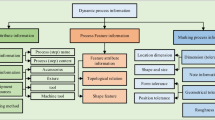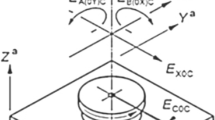Abstract
The modeling of equivalent fixture error (EFE) in machining process has been proved to be an effective way for variation reduction. However, previously developed approaches did not describe the EFE phenomenon of workpiece deformation. This paper proposes a comprehensive EFE model that can simultaneously transform the datum errors, machine tool path error and workpiece deformation to EFE. The developed model can also describe the EFE phenomenon for general fixture layouts rather than being limited to an orthogonal 3–2-1 layout case. Based on this comprehensive error compensation strategy, the datum errors, machine tool path error and workpiece deformation can be compensated for machining process with general fixture layouts. The case studies demonstrate the model validity through the real machining experiments and also show a simple simulation process for error compensation.








Similar content being viewed by others
References
Zhou S, Huang Q, Shi J (2003) State space modeling of dimensional variation propagation in multistage machining process using differential motion vectors. IEEE Trans Robot Autom 19(2):296–309
Loose JP, Zhou S, Ceglarek D (2007) Kinematic analysis of dimensional variation propagation for multistage machining processes with general fixture layouts. IEEE Trans Autom Sci Eng 4:141–152
Ramesh R, Mannan MA, Poo AN (2000) Error compensation in machine tools-a review part I: geometric, cutting-force induced and fixture dependent errors. Int J Mach Tools Manuf 40:1235–1256
Ratchev S, Liu S, Huang W, Becker A (2006) An advanced FEA based force induced error compensation strategy in milling. Int J Mach tools Manuf 46:542–551
Cai W, Hu SJ, Yuan J (1997) A variational method of robust fixture configuration design for 3-Dworkpieces. J Manuf Sci Eng 119:593–602
Choudhuri SA, De Meter EC (1999) Tolerance analysis of machining fixture locators. Transactions of the ASME, J Manuf Sci Eng 121:273–281
Chen G, Yuan J, Ni J (2001) A displacement measurement approach for machine geometric error assessment. J Manuf Sci Eng 41:149–161
Liu S, Jin S, Zhang XP, Chen K, Tian A, Xi LF (2019) A coupled model for the prediction of surface variation in face milling large-scale workpiece with complex geometry. J Manuf Sci Eng 141(3):031009–031014
Jin S, Liu S, Zhang XP, Chen K (2019) A unified prediction model of 3D surface topography in face milling considering multi-error sources. Int J Adv Manuf Technol 102(1):705–717
Okafor AC, Ertekin YM (2000) Derivation of machine tool path error models and error compensation procedure for three axes vertical machining center using rigid body kinematics. J Manuf Sci Eng 40:1199–1213
Yang J, Yuan J, Ni J (1999) Thermal error mode analysis and robust modeling for error compensation on a CNC turning center. J Manuf Sci Eng 39(9):1367–1381
Yang J, Yuan J, Ni J (1997) Real-time cutting force induced error compensation on a turning center. J Manuf Sci Eng 37(11):1597–1610
Ramesh R, Mannan MA, Poo AN (2000a) Error compensation in machine tools-a review part I: geometric, cutting-force induced and fixture dependent errors. J Manuf Sci Eng 40:1235–1256
Ramesh R, Mannan MA, Poo AN (2000b) Error compensation in machine tools-a review part II: thermal errors. J Manuf Sci Eng 40:1235–1256
Huang Q, Zhou N, Shi J (2000) Stream of variation modeling and diagnosis of Multi-Station machining processes in: proceedings of IMECE. International Mechanical Engineering Congress & Exposition 11:81–88
Zhong W, Huang Y, Hu SJ (2002) Modeling variation propagation in machining systems with different configurations. In: ASME International Mechanical Engineering Congress & Exposition, pp97–106
Djurdjanovic D, Ni J (2001) Linear state space modeling of dimensional machining errors. Transactions NAMRI/SME:541–548
Abellan-Nebot JV, Liu J, Romero F (2012) State space modeling of variation propagation in multistation machining processes considering machining-induced variations. J Manuf Sci Eng 134(2):1–13
Ceglarek D, Huang W, Zhou S, Ding Y, Kumar R, Zhou Y (2004) Time-based competition in multistage manufacturing: stream-of-variation analysis (SOVA) methodology-review. Int J Flex Manuf Sys 16(1):11–44
Shi J, Zhou S (2009) Quality control and improvement for multistage systems: a survey. IIE Trans 41(9):744–753
Abellan-Nebot JV, Subiron FR, Mira JS (2013) Manufacturing variation models in multi-station machining systems. Int J Adv Manuf Technol 64(1):63–83
Yang F, Jin S, Li Z (2017) A comprehensive study of linear variation propagation modeling methods for multistage machining processes. Int J Adv Manuf Technol 90(5–8):2139–2151
Wang H, Huang Q (2006) Error cancellation modeling and its application to machining process control. IIE Trans 38:355–364
Izquierdo L, Shi J, Hu S, Wampler C (2007) Feedforward control of multistage assembly processes using programmable tooling. Transactions of the North American Manufacturing Research Conference 35:295–302
Shirinzadeh B (2002) Flexible fixturing for workpiece positioning and constraining. Assem Autom 22:112–120
Djurdjanovic D, Ni J (2007) Online stochastic control of dimensional quality in multistation manufacturing systems. Proc Inst Mech Eng B J Eng Manuf 221:865–880
Abellan-Nebot JV, Liu J, Subiron FR (2012) Quality prediction and compensation in multi-station machining processes using sensor-based fixtures. Robot Comput-Integr Manuf 28:208–219
Wang H, Huang Q, Katz R (2005) Multi-operational machining processes modeling for sequential root cause identification and measurement reduction. J Manuf Sci Eng 127:512–521
Huang Q, Shi J (2003) Simultaneous tolerance synthesis through variation propagation modeling of multistage manufacturing processes. Transactions, NAMRC/SME, XXXI, pp 515–522
Yang F, Jin S, Li Z, Ding S, Ma X (2017) A new error compensation model for machining process based on differential motion vectors. Int J Adv Manuf Technol 93:2943–2954
Liao YG, Hu SJ (2001) (2001) an integrated model of a fixture–Workpiece system for surface quality prediction. Int J Adv Manuf Technol 17:810–818
Radhakrishnan T, Nandan U (2005) Milling force prediction using regression and neural networks. J Intell Manuf 16(1):93–102
Qu S, Zhao J, Wang T, Tian F (2015) Improved method to predict cutting force in end milling considering cutting process dynamics. Int J Adv Manuf Technol 78:1501–1510
Funding
This work has been partially supported by the National Natural Science Foundation of China (Grant Nos. 51575335), Science and Technology Commission of Shanghai Municipality (Grant No. 16030501300) and Open Project of Shanghai Key Laboratory of Digital Manufacture for Thin-walled Structures (Grant No. 2019-002). The authors would like to thank these financial supports.
Author information
Authors and Affiliations
Corresponding author
Additional information
Publisher’s note
Springer Nature remains neutral with regard to jurisdictional claims in published maps and institutional affiliations.
Rights and permissions
About this article
Cite this article
Yang, F., Xing, Y. & Li, X. A comprehensive error compensation strategy for machining process with general fixture layouts. Int J Adv Manuf Technol 107, 2707–2717 (2020). https://doi.org/10.1007/s00170-020-05148-6
Received:
Accepted:
Published:
Issue Date:
DOI: https://doi.org/10.1007/s00170-020-05148-6




